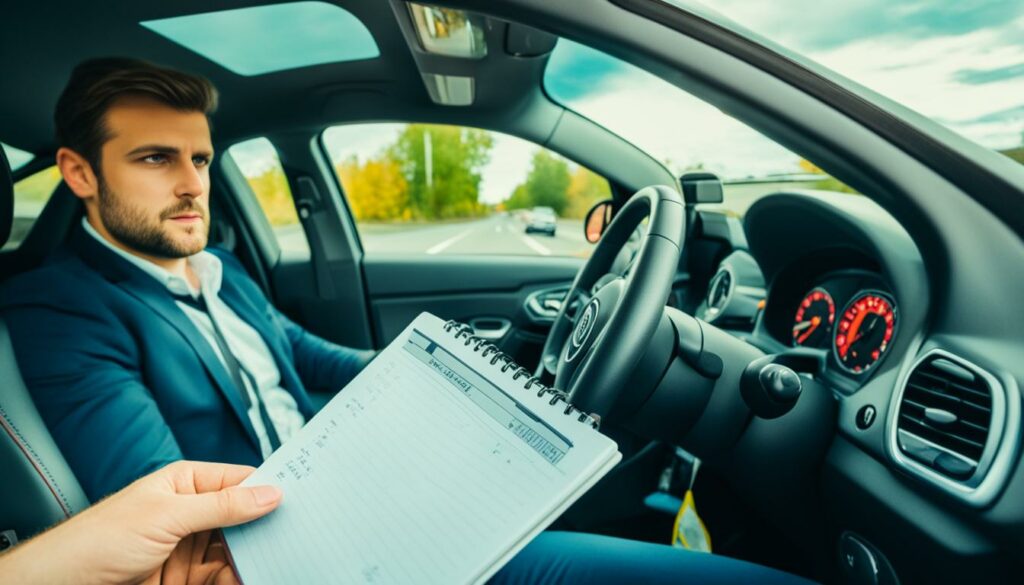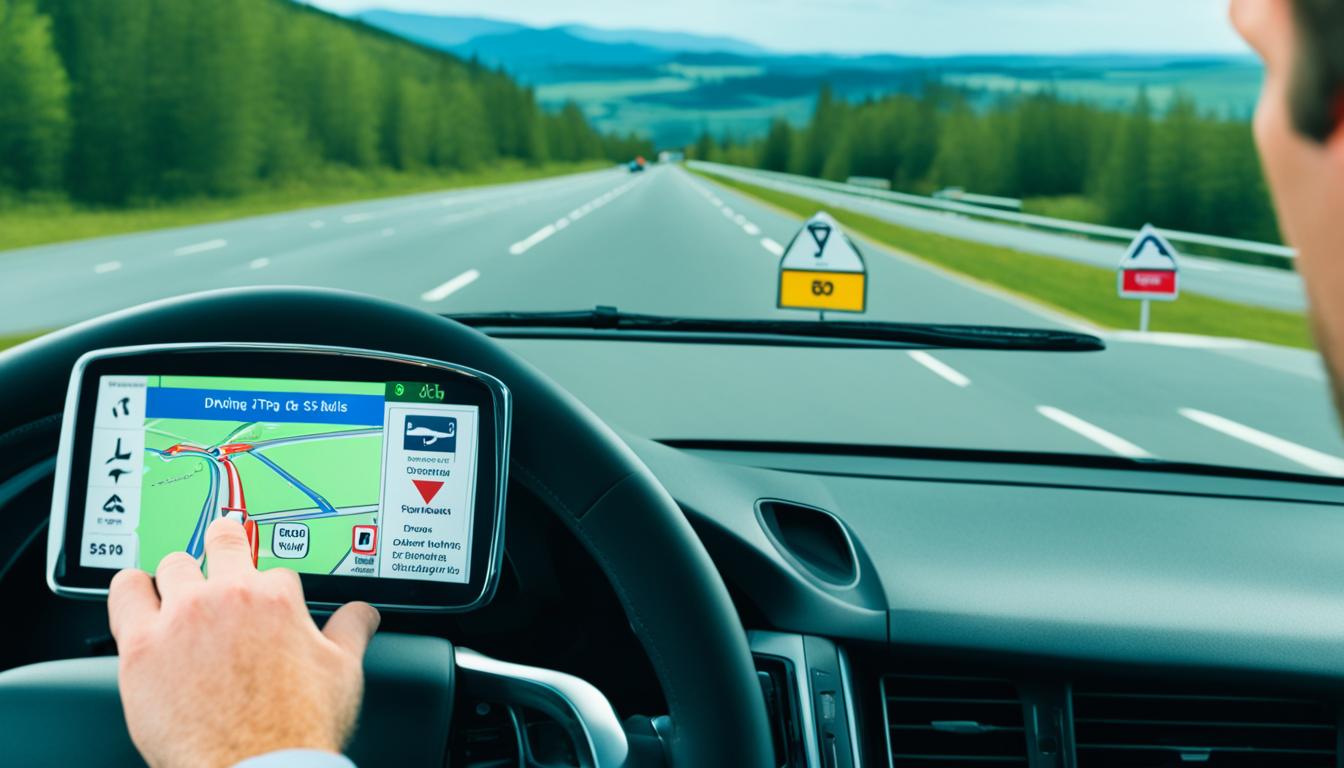Driving Skills Tips: Do You Know How to Drive?
Learning to drive is an exciting and transformative experience. However, it’s important to continuously improve your driving skills to ensure road safety. Whether you’re a new driver or someone looking to brush up on their skills, this article will provide you with valuable tips to enhance your driving abilities and become a better driver.
Key Takeaways:
- Limit distractions in the car to stay focused on the road.
- Understand your driving style and make adjustments as needed.
- Stay aware of your surroundings and practice defensive driving.
- Learn from your experiences and constantly strive to improve.
- Make time for regular practice to develop your skills.
Limit Distractions
Distractions can significantly impact your ability to drive safely. To improve your driving skills, it’s important to limit distractions in your car. By reducing these driving distractions, you can maintain focus on the road and enhance road safety.
Here are some effective ways to limit distractions while driving:
- Ensure your vehicle is in good condition: Regularly inspect your car for any visible problems that may cause distractions. This includes checking the functionality of the brakes, headlights, and indicators.
- Have a friend accompany you: Invite a friend to ride along with you while driving. They can serve as an extra pair of eyes and help spot any issues or distractions that you may miss.
- Minimize the use of electronic devices: Keep your focus on the road by reducing the use of electronic devices such as smartphones, tablets, or GPS systems. If necessary, use hands-free options or pull over safely to use these devices.
- Avoid eating or drinking while driving: Eating or drinking can divert your attention away from the road. It’s best to consume food and beverages before or after your trip.
- Secure loose items: Make sure any loose items in your car are properly secured to prevent them from shifting or falling while driving. Loose objects can be distracting and potentially dangerous.
By implementing these strategies, you can create a more focused driving environment and reduce the risk of distracted driving accidents. Remember, road safety starts with staying alert and minimizing distractions.
Know Yourself

Understanding your driving style is essential for improving your skills. By identifying any aggressive driving traits, such as excessive honking, you can make efforts to modify your behavior and become a more considerate driver.
Aggressive driving can lead to road rage situations and compromise safety. It’s important to be aware of how your driving style impacts others on the road and take proactive steps to prevent any potential conflicts.
By being conscious of your driving style, you can make adjustments that contribute to a safer driving environment for everyone. Remember, small changes in behavior can have a significant impact on the overall driving experience.
Effects of Aggressive Driving:
- Increased chances of accidents
- Poor road etiquette
- Elevated stress levels
- Decreased overall driving enjoyment
- Tarnished reputation as a driver
Recognizing the importance of self-awareness, take the initiative to evaluate your driving style and reflect on your behavior on the road. Making a conscious effort to be more considerate and understanding can go a long way towards creating a positive driving environment.
Be Aware of Your Surroundings

Being aware of your surroundings is crucial for safe driving. When on a busy road, it is important to practice defensive driving techniques and maintain a safe distance from other vehicles. By keeping a sufficient distance, you allow yourself room for maneuvering if needed, reducing the risk of sudden braking and accidents.
Defensive driving involves staying alert and anticipating potential situations on the road. By constantly scanning your environment, checking blind spots, and staying mindful of road conditions, you can proactively prevent accidents and ensure the safety of yourself and others.
Here are some defensive driving tips to enhance your road awareness:
- Keep your eyes on the road and avoid distractions, such as using your phone or eating while driving.
- Scan the road ahead and check for any potential hazards, such as pedestrians, cyclists, or sudden changes in traffic flow.
- Use your mirrors frequently to monitor the movement of vehicles around you.
- Signal your intentions early to communicate with other drivers and avoid any confusion.
- Follow the speed limit and adjust your speed according to road conditions, such as weather or traffic congestion.
- Be cautious at intersections and yield the right of way when necessary.
- Stay calm and patient in heavy traffic or challenging driving situations, as this can help you make better decisions.
By practicing defensive driving and being aware of your surroundings, you can greatly reduce the risk of accidents and ensure a safer driving experience for yourself and others on the road.
Quote:
“Road awareness is not just about watching the road ahead; it’s about staying vigilant and being prepared for anything that may come your way.”
| Tips for Road Awareness: | Benefits of Defensive Driving: |
|---|---|
| 1. Stay focused and avoid distractions. | 1. Reduces the risk of accidents. |
| 2. Regularly check your mirrors and blind spots. | 2. Increases your ability to anticipate potential hazards. |
| 3. Signal your intentions to communicate with other drivers. | 3. Enhances overall road safety. |
| 4. Adjust your speed according to road conditions. | 4. Improves your decision-making skills. |
| 5. Yield the right of way and follow traffic rules. | 5. Reduces stress and promotes a calmer driving experience. |
Learn from Experience

As a new driver, it’s natural to make mistakes and have room for improvement. Monitoring your driving habits and actively seeking areas to enhance your skills is crucial. Take time to reflect on your driving performance and evaluate the level of safety in your driving. By learning from your experiences and striving for continuous improvement, you can develop your driving skills and become a safer driver.
Reflecting on your experience behind the wheel allows you to identify any patterns or behaviors that may pose risks on the road. It’s essential to pay attention to your driving habits, such as speeding, harsh braking, or not using signals appropriately. By identifying these habits, you can actively work on eliminating them and adopting safer alternatives.
Take this opportunity to evaluate your knowledge of traffic rules and road signs. Brush up on areas where you may feel uncertain to ensure that you are well-informed and confident when navigating the roads.
Learning from experience is a continuous process that helps new drivers gain confidence, proficiency, and a deeper understanding of safe driving practices. The mistakes we make on the road can serve as valuable lessons, guiding us toward becoming responsible and skilled drivers.
Benefits of Evaluating Your Safe Driving Skills
- Identify areas for improvement
- Enhance your overall driving skills
- Develop a safety-conscious mindset
- Reduce the risk of accidents
- Become a more confident and vigilant driver
Remember, every moment spent behind the wheel is an opportunity for growth. By learning from your experiences and actively evaluating your safe driving practices, you can progress as a new driver, ensuring road safety for yourself and others.
Make Time for Practice

Practicing regularly is crucial for improving your driving skills. Dedicate time to honing your abilities and becoming a more confident driver. Here are some tips to help you make the most of your practice sessions:
- Schedule driving lessons: Consider enrolling in professional driving lessons to learn from experienced instructors. They can provide valuable guidance and help you develop essential skills.
- Create a practice routine: Set aside specific times for practice in your schedule. Treat it as a priority and commit to regular practice sessions. Consistency is key to improving your driving skills.
- Cover various aspects of driving: When practicing, focus on different areas such as parking, highway driving, and navigating challenging road conditions. By addressing different aspects of driving, you can ensure comprehensive skill development.
- Take advantage of driving simulators: Using driving simulators can be a beneficial supplement to on-road practice. They can help you experience different driving scenarios and improve your decision-making skills.
- Review and reflect: After each practice session, take the time to reflect on your performance. Identify areas where you can improve and set goals for the next practice session.
Remember, practice makes perfect. By making time for regular practice and focusing on specific areas of improvement, you can enhance your driving skills and become a safer, more confident driver.
Be Active on the Road
Physical fitness plays a significant role in driving safely and confidently. Engaging in regular driver training not only enhances your driving abilities but also makes the entire driving experience more enjoyable. By staying active and participating in driver training programs, you can improve your skills and become a better driver.
Physical fitness is directly linked to better reflexes, coordination, and focus, which are essential for safe and effective driving. Maintaining a healthy lifestyle through regular exercise and proper nutrition can significantly enhance your physical capabilities on the road.
Driver training programs offer valuable opportunities to learn and practice advanced driving techniques. These programs focus on improving defensive driving skills, hazard perception, and decision-making abilities. By actively participating in driver training, you can gain valuable insights, refine your driving techniques, and master complex maneuvers.
Additionally, driver training programs provide a supportive and interactive environment where you can learn from experienced instructors and exchange experiences with fellow learners. This collaborative approach enhances the learning process and allows you to benefit from the collective wisdom of others.
Remember, driving is not just a means of transportation; it can be a source of joy and fulfillment. Embrace the journey, and make the most out of every drive.
Incorporating physical fitness activities and driver training into your routine can have a transformative impact on your driving skills and overall enjoyment. By prioritizing your physical well-being and actively participating in driver training, you can become a safer, more confident driver on the road.
Benefits of Physical Fitness for Driving
| Benefits | Description |
|---|---|
| Improved Focus | A fit and healthy body enhances concentration and attention, allowing you to stay focused on the road for extended periods. |
| Better Reaction Time | Regular exercise improves your reflexes, enabling you to react quickly to unexpected situations on the road. |
| Enhanced Coordination | Physical fitness activities enhance hand-eye coordination and overall motor skills, which are essential for precise control of the vehicle. |
| Reduced Fatigue | A healthy body is more resilient to fatigue, allowing you to drive longer distances without experiencing excessive tiredness. |
| Lower Stress Levels | Exercise releases endorphins, which reduce stress and promote a calm state of mind while driving. |
Follow Traffic Rules
Strictly adhering to traffic rules and regulations is essential for road safety. By understanding and practicing traffic rules set by your local transportation authority, you can contribute to safer roads and become a more confident driver.
When it comes to road safety, following traffic rules plays a crucial role. These rules are put in place to ensure the smooth flow of traffic, minimize accidents, and protect the well-being of all road users. By complying with traffic regulations, you not only protect yourself but also contribute to the overall safety of the community.
Here are some important traffic rules to remember:
- Obey traffic signs and signals: Stop at red lights, yield to pedestrians, and follow the instructions given by traffic signs and signals. This helps maintain order on the road and prevents potential accidents.
- Respect speed limits: Adhere to the designated speed limits on different roads. Speeding not only puts your life at risk but also endangers the lives of others.
- Use turn signals: Indicate your intentions by using your turn signals when changing lanes or making turns. This allows other drivers to anticipate your actions and ensures a smooth flow of traffic.
- Give way to emergency vehicles: When you hear the sirens or see emergency vehicles approaching, move to the side of the road and give them the right of way. This helps prioritize their response and potentially save lives.
- Keep a safe distance: Maintain a safe following distance from the vehicle in front of you. This gives you enough time to react to sudden changes and helps prevent accidents.
- Wear seatbelts: Buckle up and ensure all passengers in your vehicle are properly restrained. Seatbelts significantly reduce the risk of injury or fatality in the event of a collision.
By following these traffic rules, you not only promote road safety but also create a harmonious environment for all road users. Remember, your actions on the road have a direct impact on the well-being of others, so it’s important to drive responsibly and confidently.
Conclusion
Being a new driver can be both exciting and daunting. However, with the right approach and a commitment to safe driving, you can become a skilled and confident driver on the road. By implementing the driving tips discussed in this article, you can enhance your driving skills and prioritize the safety of yourself and others.
Remember to stay focused while behind the wheel and minimize distractions. Be aware of your surroundings and practice defensive driving techniques to prevent accidents. Regularly reflect on your driving experience, learn from any mistakes, and strive to continuously improve your skills.
If you feel the need for professional guidance, consider seeking instruction from experienced driving instructors. Their expertise and guidance can help you develop the necessary skills and confidence to navigate the roads safely. Safe driving is an ongoing process, and with dedication and persistence, you can become a responsible and competent driver.
FAQ
What are some tips for improving driving skills?
To improve your driving skills, limit distractions in your car, be aware of your driving style, maintain awareness of your surroundings, learn from experience, make time for practice, stay physically fit, follow traffic rules, and seek guidance from professional driving instructors if needed.
How can I limit distractions while driving?
To limit distractions, ensure your vehicle is in good condition, free from any visible problems, and have a friend accompany you while driving to spot any issues. By reducing distractions, you can maintain focus on the road and enhance your driving abilities.
How can I improve my driving style?
Understanding your driving style is essential for improving your skills. Identify any aggressive driving traits, such as excessive honking, and make efforts to modify your behavior. By being aware of your driving style, you can make adjustments and become a more considerate driver.
Why is it important to be aware of my surroundings while driving?
Being aware of your surroundings is crucial for safe driving. When on a busy road, maintaining a safe distance from other vehicles allows room for maneuvering if needed. This prevents sudden braking and reduces the risk of accidents. By staying alert and anticipating potential situations, you can proactively prevent accidents and navigate the road more effectively.
How can I learn from my driving experiences?
No driver is perfect, especially when starting out. As a new driver, it’s important to monitor your driving habits and actively seek areas for improvement. Reflect on your driving performance and evaluate how safe your driving is. By learning from experience and continuously improving, you can enhance your driving skills and become a safer driver.
How can I make time for practice?
Practicing regularly is key to developing your driving skills. Create a routine that includes checking your car’s condition, scheduling driving lessons, and allotting time for practice. Cover various aspects of driving to ensure comprehensive skill development. By dedicating time to practice, you can gain confidence, become familiar with different driving scenarios, and improve your overall driving abilities.
How does physical fitness contribute to better driving?
Being physically fit is beneficial for driving. Engage in regular driver training to enhance your driving abilities. Physical fitness not only improves your driving skills but also makes your driving experience more enjoyable. By staying active and engaging in driver training, you can become a better and more confident driver.
Why is it important to follow traffic rules?
Strictly adhering to traffic rules and regulations is essential for road safety. Memorize and practice following traffic rules set by your local transportation authority. Understanding and following traffic rules will make you a more confident driver and contribute to safer roads.
How can I become a safer and more confident driver?
Driving is a skill that requires practice and continuous improvement. By implementing the tips mentioned in this article, such as limiting distractions, knowing yourself, being aware of your surroundings, learning from experience, making time for practice, being active on the road, following traffic rules, staying alert, not rushing, and being patient, you can enhance your driving skills and become a better driver.







